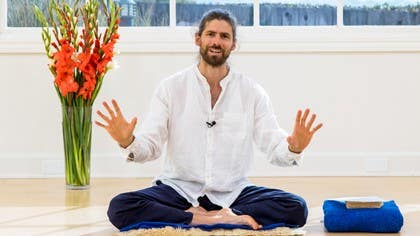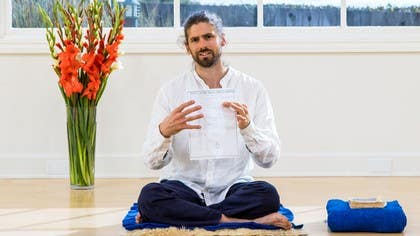Description
About This Video
Transcript
Read Full Transcript
So this is the first sutra of Patanjali's Yoga Sutras, Ata Yoga Anushasanam. Now there is, they will follow the sequential unfolding or presentation of yoga. Now basically here Patanjali is telling us what he's going to tell us. So now I'm going to tell you about yoga. And true to his word, from this point he will go on to tell us about yoga.
But he tells us what he's going to do right at the start. So these days if you learn to give a presentation or write an essay, they'll often tell you, tell the audience where you're going at the beginning. And Patanjali does this, this is not a new thing. But with this opening sutra, Patanjali does many other things. The first word, ata, is a word that is often used and traditionally used to start off this type of text where it's presenting a body of philosophical knowledge or wisdom.
And ata means basically now. However, it's important to note that there are different ways of saying now in Sanskrit. And this ata could also be translated as then. So it's more like and now and then. It's a now that is in relation to something that has previously been experienced or has previously happened.
So the idea of starting with ata is basically saying now. Now that I have recognized that I don't quite know myself and I'm interested in doing something about it. Now I'm ready for yoga. Now that I'm realizing that sometimes I do things that really I know I don't want to do, I still do them anyway, what's going on here? Now I'm interested in trying to resolve that.
So they say in the Veda, which is an important source for yoga, the Veda being a body of Indian text and philosophy and various teachings and writings. They say in that body of writing that when one is a human being it is altogether natural and completely normal that we experience beauty and we experience loss. That when you're a human being sooner or later we experience the joy and the sweetness of plucking the fresh fruit from the tree in its perfect state of ripeness. We experience the joy of close companionship. But before very long we also experience loss and grief.
And the Adriana yoga is this is completely normal. This is life. It's cyclical. It's coming and it's going, it's up and it's down, it's around and around. And the idea is when we experience these comings and goings, these highs, these lows, it's altogether normal that some moment at one point we start to have this idea, we might call it an awakening, there must be something more than all of this coming and going. Now, and there's the idea that any time we are arrested to the degree that we are fully pulled into the present moment, this can be a moment of awakening.
And for most people this occurs at least once or twice in their young life. And it occurs sometimes without any expectation of it. Maybe for example, you're doing something, you enjoy it and you're thoroughly absorbed in it and you find yourself feeling very, very content in that being fully absorbed in what you're doing. Or perhaps you're out somewhere and you just get struck by the beauty of nature and you're just captivated by that sensory experience of a sunset or the light coming through the forest canopy as you're walking in the woods, for example. And for a moment all of your sensing powers are just filled with that beauty.
And there's no space in that fullness for any sense of dissatisfaction. And it's like you're pulled fully wholly into the present moment. And so the idea is as we go through our life, we experience ups and downs. But we also have certain experiences that kind of give us the idea that I can do something about this being ticked up and smashed down by the comings and goings of the external world. There's the idea if we just depend on the external things, sooner or later we're going to be disappointed because we can be sure that things will change.
And so the idea in yoga is can we experience from a place of internal stability so that as things come and go, as they go up and down, we can enjoy all parts of the ride, relatively speaking, and actually stay steady. So this work begins utter now that I have realized I don't quite know myself. Now that I've realized if I just chase external things, it doesn't bring me the deep fulfillment and satisfaction that I'm really longing for. And so one thing that I would say is yoga has come to us through the Indian tradition. But I would say that yoga is not really an Indian thing.
For me, yoga is the deepest longing of the human soul. And the essential teachings of yoga can be found in spiritual traditions from every continent and from traditions from all around the world. Any time when we really get pulled into the present moment and we get pulled into that state of deeper inquiry, we get a glimpse of something deeper. If somebody close to us dies, we can get a sense of the urgency of life. This can be something that pulls us into the now.
But the idea in yoga is that now that you recognize that the way you've been operating isn't perhaps serving you as richly, as fully as it could. And then yoga begins. The yoga of inquiry, the yoga of practice, the yoga of exploration. Starting the text with ata is also a very traditional thing to do. And the idea in the Indian system is that when you start the text with ata means now, now the time prepared.
So the idea in the Indian system is that first, if you're going to study philosophy, you study grammar and you study logic so that you've got a strong frame with which you can explore the text. Now we may not have studied Indian logic or Sanskrit grammar, but it's that same sense. Now that I have recognized through my life experience that I'd like to inquire more deeply, then now I'm ready for yoga. And this is a beautiful idea also encoded in the yoga teachings, is that now is the time. If you feel the inclination, then you are ready.
There's nothing to wait for. So sometimes we have this idea that comes to us from external sources. In order to do something, we have to get a prerequisite qualification. But the idea in yoga is when you are born, you are already qualified to explore what it means to be alive, what it means to be a human being, what it means to be you. And so now, if you're watching this, it's already the time.
You don't need to think, oh, maybe I should go back and watch that other program about... No, no, no. Now it's already time. So ata now, and yoga begins now. It's not about some far-off goal.
It's about what we do here and now. Ata yoga anushasanam. Anushasanam, anu, as a prefix, means basically following, ensuing. So now there will follow the shasana of yoga. Now, shasana, shas, this verb root, basically means a codified presentation, instruction.
So it potentially tells us I'm going to give you the teachings of yoga in a codified form. I'm going to instruct you in a clear, progressive, sequential unfolding. And this is one thing that's important to note about this text. Yoga did not begin with Patanjali. I have seen certain things written about the yoga sutras that I find rather misleading.
And I have seen it written in one place that yoga began with the yoga sutras by Patanjali. But this is not possible. Because the sutra form is only ever possible when a system or a body of knowledge has been around for some good time. Because the sutra is the distillation of an already existing body of knowledge. So you can't go to the sutra form before you have already explored in quite a lot of depth.
So Patanjali's yoga sutra, people say, more or less, it's 2,000 years old, give or take two to five centuries. People generally agree about that general benchmark. But what we can be sure of is that the yoga tradition goes back much, much further. Because when Patanjali says ata yoga anushasanam, he uses this prefix anu. He is also acknowledging that he is following in the footsteps of those explorers, those researchers who have already established this system of yoga.
But what Patanjali is doing is he is making yoga into what they call in Sanskrit a shastra. And a shastra basically means a codified body of knowledge or wisdom that is set forth and set down in such a way that it is robust. It can withstand counter positions. And it is set down in such a way that it can be perpetuated. People can refer back to it.
People can use it as a solid dependable frame of reference. Because the things that are included in the shastra have been thoroughly tested over many generations. And so yoga shastra, as set forth, as encoded in the yoga sutra, is a time-tested body of very practical knowledge. And so we will see as we get into the text, Patanjali doesn't give us restrictive prescriptions. There is no prohibition in Patanjali.
Instead, we get very robust invitations. We get empowering instruction that invites us to explore for ourselves. Now one other thing to mention about this opening sutra, there is the idea in yoga that yoga is efficiency. And so if the text is truly to be a yoga text, it should demonstrate this efficiency. So we'll see in sutra number two and three, basically we get the whole teaching in essence, in seed form we might say.
But right here, even before Patanjali technically begins teaching, in this opening sutra you could also suggest that the whole teaching is encoded in a certain way. Because it sounds like this, ata yoga anushasanam. So the first syllable is uh, which is the first syllable of the Sanskrit alphabet and symbolizes the first sprouting of creative potential. And the last syllable is mm, ata yoga anushasanam. So this mm, following the uh at the start, it can remind us of om.
And the idea is that a very, very evolved practitioner, somebody who is on the cusp of becoming an established yogin, they hear ata yoga anushasanam. And the vibration of this first sutra takes them into complete integration. And such a person needn't bother carrying on. However, for the rest of us, ata yoga anushasanam, I'm not experiencing complete yoga, then let's see what he's going to tell us. Let's see what pearls of wisdom Patanjali has to offer us.
And so this is where we'll continue.
Yoga Sutras of Patanjali: Start Where You Are
Comments

You need to be a subscriber to post a comment.
Please Log In or Create an Account to start your free trial.















